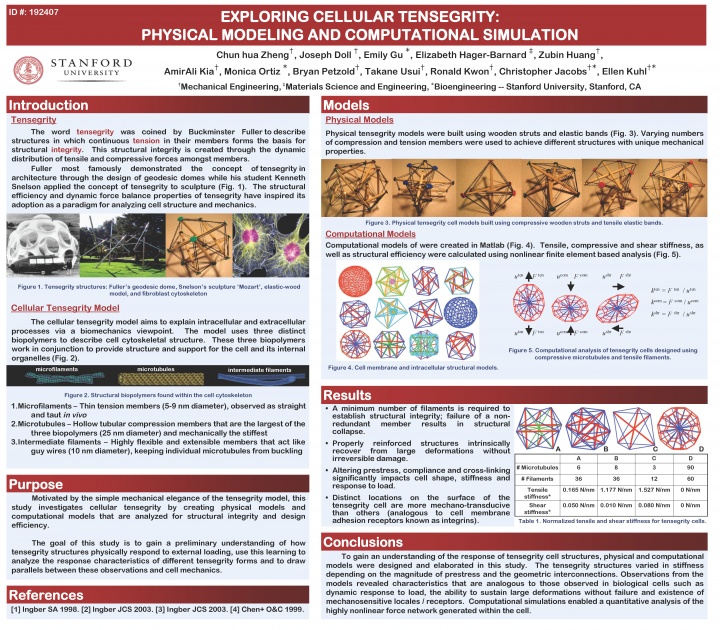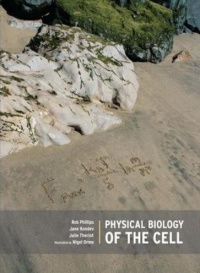Contents |
spring 12 - me239 - mechanics of the cell
|
me239 - mechanics of the cell 12 ellen kuhl, manuel rausch spring 2012 |
goals
cells are the fundamental building blocks of life. the understanding of their characteristic biological features, their motility, their biochemistry and their interaction with the environment is crucial when cells are to be applied, modified or engineered in health care and modern medical therapies. this course focuses on the mechanical aspects of the cell, which can be two fold: on the one hand, cell biology and biochemistry influence the mechanical properties of the cell; on the onther hand the mechanical environment, load, pressure, stress or strain can influence the cell's shape and integrity, and eventually its biology and biochemistry. in the first part of this course, we will discuss how cell properties can be measured experimentally and how they can be characterized in the form of equations. we will elaborate concepts of energy and entropy for different structural units of the cell: biopolymers, i.e., microtubules, actin, and intermediate filaments and biomembranes, i.e., the lipid bi-layer that forms the cell membrane. to explore the cell's behavior in silico, we will introduce computational simulation tools. in the second part, we address aspects of mechanotransduction. we discuss different aspects of how cells sense loads and how signals are transmitted within the cell and through the extracellular matrix.
grading
- 30 % homework - 3 homework assignments, 10% each
- 30 % midterm - closed book, closed notes, one single page cheat sheet
- 20 % final project oral presentations - graded by the class
- 20 % final project essay - graded by instructor
syllabus
| day | date | topic | notes | material | |
|---|---|---|---|---|---|
| tue | apr | 03 | introduction I - cell biology | s01 | |
| thu | apr | 05 | introduction II - cytoskeletal biology, stem cells | n02 | s02 l02 |
| tue | apr | 10 | introduction III - structural mechanics | n03 | s03 |
| thu | apr | 12 | biopolymers I - energy, tension, bending | n04 | s04 |
| thu | apr | 12 | homework I - biopolymers, directed stem cell differentiation | h01 | m04 |
| tue | apr | 17 | biopolymers II - entropy, FJC and WLC model | n05 | s05 |
| thu | apr | 19 | biopolymers III - polymerization kinetics in amoeba | n06 | s06 m06 |
| tue | apr | 24 | cytoskeletal mechanics I - fiber bundle model for filopodia | n07 | s07 m07 |
| thu | apr | 26 | cytoskeletal mechanics II - network model for red blood cells | n08 | s08 |
| thu | apr | 26 | homework II - cytoskeleton, cell mechanics challenges | h02 | m10 |
| tue | may | 01 | cytoskeletal mechanics III - tensegrity model for generic eukaryotic cells | n09 | s09 m09 |
| thu | may | 03 | biomembranes I - micropipette aspiration in white blood cells and cartilage cells | n10 | s10 |
| tue | may | 08 | biomembranes II - lipid bilayer, soap bubble, cell membrane | n11 | s11 |
| thu | may | 10 | biomembranes III - energy, tension, shear, bending | n12 | s12 |
| tue | may | 15 | mechanotransduction I - inter- and intracellular signaling, bone cells | n13 | s13 |
| tue | may | 15 | homework III - micropipette aspiration, final project | h03 | m12 |
| thu | may | 17 | summary and midterm preparation | n14 | s14 |
| tue | may | 22 | midterm | ||
| thu | may | 24 | mechanotransduction II - electrophysiology in nerve cells | n16 | s16 |
| tue | may | 29 | mechanotransduction III - excitation contraction in skeletal muscle and heart cells | n17 | s17 |
| thu | may | 31 | final projects I - oral presentations | n18 | l01 l02 |
| tue | jun | 05 | final projects II - oral presentations | p01 | |
| thu | jun | 07 | no class | ||
| fri | jun | 08 | final projects - written projects due | p02 |
copyright ron kwon, ellen kuhl, chris jacobs, stanford, fall 2007, ellen kuhl, fall 2008, ellen kuhl, spring 2010
course summary
course summary developed in last year's class
42 answers to life, the universe, and everything
example of final project
predicting microtubules structure using molecular dynamics, mechanotransduction in hair cells: translating sound waves into neural signals, modeling cell membrane dynamics, fast and slow adaptation in inner ear hair cells, dielectrophoresis properties and their microfluidic application, cell concentrator, theoretical and experimental study of the mechanics of penetration of the cell membrane, integrin and its role in mechanotransduction, finite element analysis of cell deformation, the tensegrity paradigm, the primary cilium: a well-designed fluid flow sensor (download example)
zheng c, doll jc, gu e, hager-barnard e, huang z, kia aa, ortiz m, petzold b, shi y, suk sd, usui t, kwon r, jacobs c, kuhl e. exploring cellular tensegrity: physical modeling and computational simulation. proceedings of the ASME 2008 summer bioengineering conference 2008, marco island, florida. SBC2008-192407 (download).
additional reading
|
(1) phillips r, kondev j, theriot j.
physical biology of the cell, garland science, 2008 (2) boal d.
mechanics of the cell, cambridge university press, cambridge, 2002 (3) howard j.
mechanics of motor proteins and the cytoskeleton, sinauer associates, sunderland, 2001 (4) alberts b et al.
molecular biology of the cell, garland science, taylor & francis, new york, 2002 |



